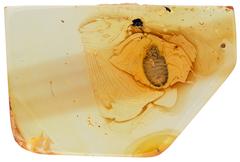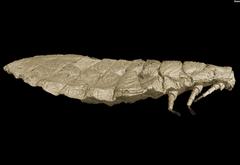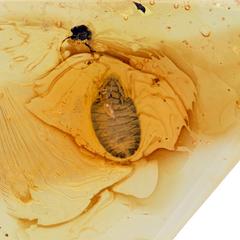URL: https://www.desy.de/news/news_search/index_eng.html
Breadcrumb Navigation
DESY News: 3D X-ray view of an amber fossil
News
News from the DESY research centre
3D X-ray view of an amber fossil
With the intense X-ray light from DESY's particle accelerator PETRA III, researchers have investigated an unusual find: a 50-million-year-old insect larva from the era of the Palaeogene. The results offer a unique insight into the development of the extinct insect, as the team reports in the journal Arthropod Systematics & Phylogeny.

Strepsiptera are parasites that infest other insects, such as bees and wasps, but also silverfish. “In most of the approximately 600 known species, the females remain in their host throughout their lives,” says Pohl. “Only the males leave it for the wedding flight, but then live only a few hours.” But there are exceptions: In species that infest silverfish, the wingless females also leave their host.
Some time ago, the Jena researchers succeeded in making a remarkable discovery: they were able to identify a nearly 100-million-year-old fossil of a twisted-wing larva in its first developmental stage, enclosed in an amber. With their size of just 0.2 millimetres, such larvae are among the smallest multi-cellular organisms known.

The problem: “Under the light microscope, essential details could not be seen,” explains Pohl. “It was not possible to see whether the larva had antennae or what the mouth parts and eyes were like and whether it was a female or a male larva.” His team therefore focused on the object using a high-resolution X-ray method - microtomography with synchrotron radiation.
To do this, they had to move to a large scientific facility – the PETRA III storage ring at DESY in Hamburg. Here, the Helmholtz Centre Geesthacht (HZG) operates the measuring station P05, which usually deals with materials research. “The method is similar to a CT scanner in a hospital, producing three-dimensional images of the inside of a body,” says HZG researcher Jörg Hammel.

Of the twisted-wing larva, the method delivered pin sharp images with a resolution of 1.3 micrometers. “All the important details can be seen on it,” Hans Pohl says. “Among other things, we were able to see that it was probably in its third larval stage and that it was very probably a female larva of Mengea, a genus that is extinct today.” What is special, the female larva had left its host – a behaviour known only from the silverfish parasites among today's Strepsiptera species. “Some evidence suggests that the host may have been a cockroach,” reports Pohl. “To be certain, however, we would have to track down and analyse more fossils.”
It is quite possible that these analyses will then again be conducted at PETRA III. “In recent years, the HZG beamline seems to have become an insider tip among biologists,” says Jörg Hammel. “Apparently, we did become so good at analysing amber fossils that we are receiving more and more enquiries from experts.”
Reference:
The first fossil free-living late instar larva of Strepsiptera (Insecta); Hans Pohl, Jörg U. Hammel, Adrian Richter, Rolf G. Beutel; Arthropod Systematics & Phylogeny, 2019; DOI: 10.26049/ASP77-1-2019-06




